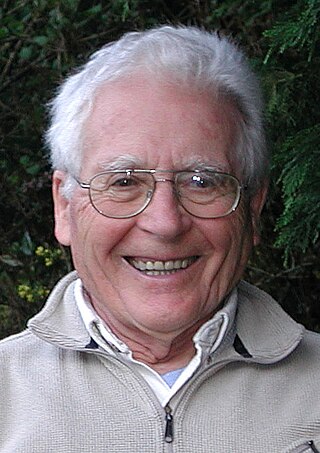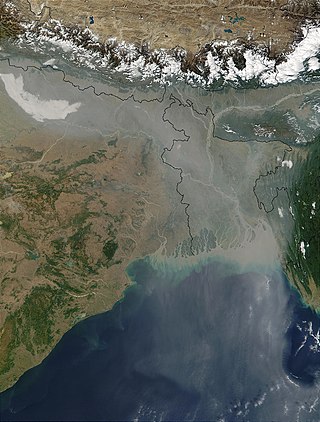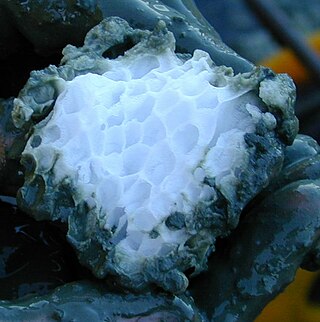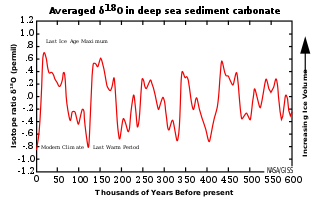Related Research Articles

Ecology is the study of the relationships among living organisms, including humans, and their physical environment. Ecology considers organisms at the individual, population, community, ecosystem, and biosphere level. Ecology overlaps with the closely related sciences of biogeography, evolutionary biology, genetics, ethology, and natural history. Ecology is a branch of biology, and it is not synonymous with environmentalism.

James Ephraim Lovelock was an English independent scientist, environmentalist and futurist. He is best known for proposing the Gaia hypothesis, which postulates that the Earth functions as a self-regulating system.

The carbon cycle is that part of the biogeochemical cycle by which carbon is exchanged among the biosphere, pedosphere, geosphere, hydrosphere, and atmosphere of Earth. Other major biogeochemical cycles include the nitrogen cycle and the water cycle. Carbon is the main component of biological compounds as well as a major component of many minerals such as limestone. The carbon cycle comprises a sequence of events that are key to making Earth capable of sustaining life. It describes the movement of carbon as it is recycled and reused throughout the biosphere, as well as long-term processes of carbon sequestration (storage) to and release from carbon sinks.

Daisyworld, a computer simulation, is a hypothetical world orbiting a star whose radiant energy is slowly increasing or decreasing. It is meant to mimic important elements of the Earth-Sun system. James Lovelock and Andrew Watson introduced it in a paper published in 1983 to illustrate the plausibility of the Gaia hypothesis. In the original 1983 version, Daisyworld is seeded with two varieties of daisy as its only life forms: black daisies and white daisies. White petaled daisies reflect light, while black petaled daisies absorb light. The simulation tracks the two daisy populations and the surface temperature of Daisyworld as the sun's rays grow more powerful. The surface temperature of Daisyworld remains almost constant over a broad range of solar output.

The Gaia hypothesis, also known as the Gaia theory, Gaia paradigm, or the Gaia principle, proposes that living organisms interact with their inorganic surroundings on Earth to form a synergistic and self-regulating, complex system that helps to maintain and perpetuate the conditions for life on the planet.

Cloud condensation nuclei (CCNs), also known as cloud seeds, are small particles typically 0.2 µm, or one hundredth the size of a cloud droplet. CCNs are a unique subset of aerosols in the atmosphere on which water vapour condenses. This can affect the radiative properties of clouds and the overall atmosphere. Water requires a non-gaseous surface to make the transition from a vapour to a liquid; this process is called condensation.
The faint young Sun paradox or faint young Sun problem describes the apparent contradiction between observations of liquid water early in Earth's history and the astrophysical expectation that the Sun's output would be only 70 percent as intense during that epoch as it is during the modern epoch. The paradox is this: with the young sun's output at only 70 percent of its current output, early Earth would be expected to be completely frozen – but early Earth seems to have had liquid water and supported life.

An abrupt climate change occurs when the climate system is forced to transition at a rate that is determined by the climate system energy-balance. The transition rate is more rapid than the rate of change of the external forcing, though it may include sudden forcing events such as meteorite impacts. Abrupt climate change therefore is a variation beyond the variability of a climate. Past events include the end of the Carboniferous Rainforest Collapse, Younger Dryas, Dansgaard-Oeschger events, Heinrich events and possibly also the Paleocene–Eocene Thermal Maximum. The term is also used within the context of climate change to describe sudden climate change that is detectable over the time-scale of a human lifetime, possibly as the result of feedback loops within the climate system or tipping points.

Tyler Volk is Professor Emeritus of Environmental Studies and Biology at New York University.

Earth's climate system is a complex system with five interacting components: the atmosphere (air), the hydrosphere (water), the cryosphere, the lithosphere and the biosphere. Climate is the statistical characterization of the climate system, representing the average weather, typically over a period of 30 years, and is determined by a combination of processes in the climate system, such as ocean currents and wind patterns. Circulation in the atmosphere and oceans is primarily driven by solar radiation and transports heat from the tropical regions to regions that receive less energy from the Sun. The water cycle also moves energy throughout the climate system. In addition, different chemical elements, necessary for life, are constantly recycled between the different components.

The Revenge of Gaia: Why the Earth is Fighting Back – and How We Can Still Save Humanity (2006) is a book by James Lovelock. Some editions of the book have a different, less optimistic subtitle: Earth's Climate Crisis and the Fate of Humanity.

The 100,000-year problem of the Milankovitch theory of orbital forcing refers to a discrepancy between the reconstructed geologic temperature record and the reconstructed amount of incoming solar radiation, or insolation over the past 800,000 years. Due to variations in the Earth's orbit, the amount of insolation varies with periods of around 21,000, 40,000, 100,000, and 400,000 years. Variations in the amount of incident solar energy drive changes in the climate of the Earth, and are recognised as a key factor in the timing of initiation and termination of glaciations.

The CLAW hypothesis proposes a negative feedback loop that operates between ocean ecosystems and the Earth's climate. The hypothesis specifically proposes that particular phytoplankton that produce dimethyl sulfide are responsive to variations in climate forcing, and that these responses act to stabilise the temperature of the Earth's atmosphere. The CLAW hypothesis was originally proposed by Robert Jay Charlson, James Lovelock, Meinrat Andreae and Stephen G. Warren, and takes its acronym from the first letter of their surnames.

Polar amplification is the phenomenon that any change in the net radiation balance tends to produce a larger change in temperature near the poles than in the planetary average. This is commonly referred to as the ratio of polar warming to tropical warming. On a planet with an atmosphere that can restrict emission of longwave radiation to space, surface temperatures will be warmer than a simple planetary equilibrium temperature calculation would predict. Where the atmosphere or an extensive ocean is able to transport heat polewards, the poles will be warmer and equatorial regions cooler than their local net radiation balances would predict. The poles will experience the most cooling when the global-mean temperature is lower relative to a reference climate; alternatively, the poles will experience the greatest warming when the global-mean temperature is higher.
Andrew James Watson FRS is a British marine and atmospheric scientist and an expert in processes affecting atmospheric carbon dioxide and oxygen concentrations. He was formerly a Professor of biogeochemistry in the School of Environmental Sciences at the University of East Anglia, in 2013 he moved to a position as Professor at the College of Life and Environmental Sciences at the University of Exeter.

In climate science, a tipping point is a critical threshold that, when crossed, leads to large and often irreversible changes in the climate system. If tipping points are crossed, they are likely to have severe impacts on human society. Tipping behavior is found across the climate system, in ecosystems, ice sheets, and the circulation of the ocean and atmosphere.
The Medea hypothesis is a term coined by paleontologist Peter Ward for a hypothesis that contests the Gaian hypothesis and proposes that multicellular life, understood as a superorganism, may be self-destructive or suicidal. The metaphor refers to the mythological Medea, who kills her own children.

Climate change feedbacks are effects of global warming that amplify or diminish the effect of forces that initially cause the warming. Positive feedbacks enhance global warming while negative feedbacks weaken it. Feedbacks are important in the understanding of climate change because they play an important part in determining the sensitivity of the climate to warming forces. Climate forcings and feedbacks together determine how much and how fast the climate changes. Large positive feedbacks can lead to tipping points—abrupt or irreversible changes in the climate system—depending upon the rate and magnitude of the climate change.
Ocean dynamical thermostat is a physical mechanism through which changes in the mean radiative forcing influence the gradients of sea surface temperatures in the Pacific Ocean and the strength of the Walker circulation. Increased radiative forcing (warming) is more effective in the western Pacific than in the eastern where the upwelling of cold water masses damps the temperature change. This increases the east-west temperature gradient and strengthens the Walker circulation. Decreased radiative forcing (cooling) has the opposite effect.
Bette Otto-Bliesner is an earth scientist known for her modeling of Earth's past climate and its changes over different geological eras.
References
- 1 2 "Professor Tim Lenton Chair in Climate Change/Earth Systems Science". University of Exeter. Retrieved 22 July 2012.
- ↑ "Royal Society announces new round of Wolfson Research Merit Awards". Royal Society. 26 April 2013. Retrieved 23 April 2014.
- ↑ "Tim Lenton". Faculty of 1000 . Retrieved 8 October 2016.
- ↑ Lenton, T. (1998). "Gaia and Natural Selection". Nature . 394 (6692): 439–447. Bibcode:1998Natur.394..439L. doi:10.1038/28792. PMID 9697767. S2CID 4412683.
- ↑ Lenton, Tim (20 March 2011). Revolutions that Made the Earth. OUP Oxford. ISBN 9780199587049.
- ↑ Carrington, Damian (2023-05-22). "Global heating will push billions outside 'human climate niche'". The Guardian. ISSN 0261-3077 . Retrieved 2023-08-21.
- ↑ "The scourge of climate doomism | Financial Times". www.ft.com. Retrieved 2023-08-21.
- ↑ "A Sustainable Future: Prof. Tim Lenton, on Planetary Boundaries, Early Warning Systems and Climate Tipping Points | Man Institute". www.man.com. Retrieved 2023-08-21.